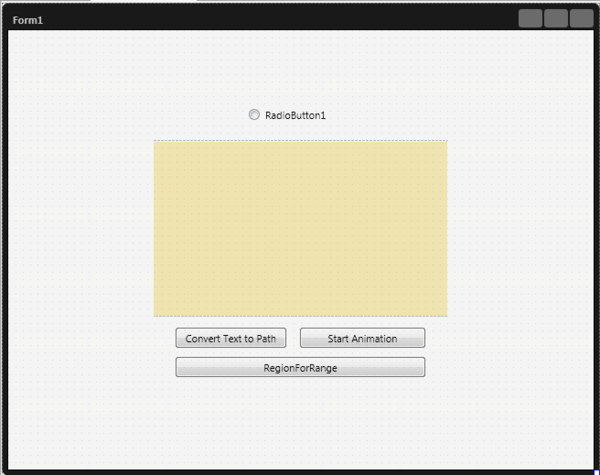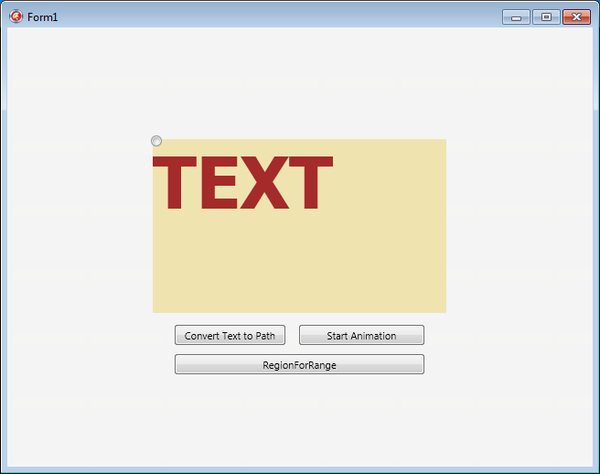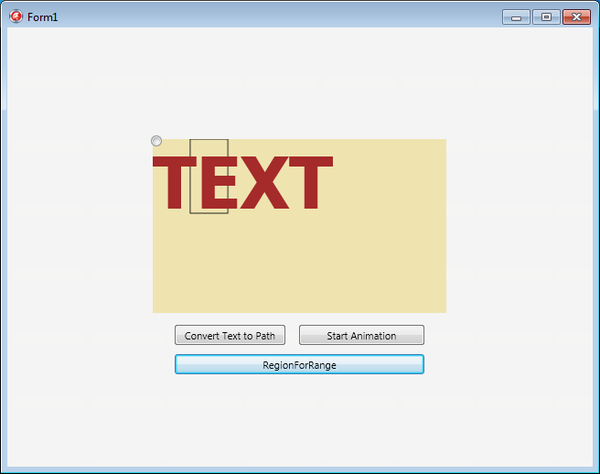Utilisation des fonctions de disposition de texte de FireMonkey
Remonter à Disposition de texte FireMonkey
L'exemple suivant montre comment utiliser les fonctions de disposition de texte disponibles dans FireMonkey. L'exemple contient du code illustrant comment effectuer le rendu d'un texte sur un objet TImage et comment utiliser les méthodes PositionAtPoint, RegionForRange et ConvertToPath.
Sommaire
Création d'une application multi-périphérique vide
- Créez une nouvelle application multi-périphérique vide.
- Depuis la palette d'outils, ajoutez les composants suivants à la fiche :
- Un TImage
- Un TRadioButton
- Trois TButton
- Depuis l'inspecteur d'objets, créez des gestionnaires d'événements pour l'événement OnCreate de TForm, l'événement OnPaint de TImage et l'événement OnClick de chaque TButton.
Ajout du code utilisant la disposition de texte
- Ajoutez les déclarations suivantes :
Dans Delphi :
MyLayout: TTextLayout;
PathAnimation1: TPathAnimation;
Dans C++ :
//fichier d'en-tête
TPathAnimation *PathAnimation1;
TTextLayout *MyLayout;
Dans Delphi :
procedure TForm1.FormCreate(Sender: TObject);
begin
RadioButton1.Position.X := Image1.Position.X - 5;
RadioButton1.Position.Y := Image1.Position.Y - 5;
RadioButton1.Text := '';
end;
Dans C++ :
void __fastcall TForm1::FormCreate(TObject *Sender) {
RadioButton1->Position->X = Image1->Position->X - 5;
RadioButton1->Position->Y = Image1->Position->Y - 5;
RadioButton1->Text = "";
}
Dans Delphi :
procedure TForm1.Image1Paint(Sender: TObject; Canvas: TCanvas;
const ARect: TRectF);
var
WPosition: Integer;
begin
MyLayout := TTextLayoutManager.DefaultTextLayout.Create;
MyLayout.BeginUpdate;
MyLayout.TopLeft := TPointF.Create(0, 0);
MyLayout.Font.Size := 78;
MyLayout.Font.Family := 'Tahoma';
MyLayout.Font.Style := [TFontStyle.fsBold];
MyLayout.Text := 'TEXT';
MyLayout.Color := TAlphaColorRec.Brown;
WPosition := MyLayout.PositionAtPoint(TPointF.Create(159, 120));
MyLayout.AddAttribute(TTextRange.Create(WPosition, 3),
TTextAttribute.Create(TFont.Create, TAlphaColorRec.Black));
MyLayout.EndUpdate;
MyLayout.RenderLayout(Canvas);
end;
Dans C++ :
void __fastcall TForm1::Image1Paint(TObject *Sender, TCanvas *Canvas,
const TRectF &ARect)
{
int WPosition;
Fmx::Graphics::TFont *font;
MyLayout = TTextLayoutManager::TextLayoutForClass
(TTextLayoutManager::DefaultTextLayout);
MyLayout->BeginUpdate();
MyLayout->TopLeft = TPointF(0, 0);
MyLayout->Font->Size = 78;
MyLayout->Font->Family = "Tahoma";
MyLayout->Font->Style = TFontStyles(1);
MyLayout->Text = "TEXT";
MyLayout->Color = TAlphaColorRec::Brown;
WPosition = MyLayout->PositionAtPoint(TPointF(159, 120));
MyLayout->AddAttribute(TTextRange(WPosition, 3),
TTextAttribute(font, TAlphaColorRec::Black));
MyLayout->EndUpdate();
MyLayout->RenderLayout(Canvas);
}
- 3. Ajoutez le code suivant aux gestionnaires d'événements OnClick de TButton afin de convertir le texte en chemin et de démarrer l'animation :
Dans Delphi :
procedure TForm1.Button1Click(Sender: TObject);
var
PathD: TPathData;
begin
PathAnimation1 := TPathAnimation.Create(Self);
PathAnimation1.Parent := RadioButton1;
PathD := TPathData.Create();
MyLayout.ConvertToPath(PathD);
PathAnimation1.Path := PathD;
PathAnimation1.Loop := True;
PathAnimation1.Duration := 50;
end;
procedure TForm1.Button2Click(Sender: TObject);
begin
PathAnimation1.Start;
end;
Dans C++ :
void __fastcall TForm1::Button1Click(TObject *Sender) {
TPathData *PathD;
PathAnimation1 = new TPathAnimation(this);
PathAnimation1->Parent = RadioButton1;
PathD = new TPathData();
MyLayout->ConvertToPath(PathD);
PathAnimation1->Path = PathD;
PathAnimation1->Loop = true;
PathAnimation1->Duration = 50;
}
void __fastcall TForm1::Button2Click(TObject *Sender) {
PathAnimation1->Start();
}
Dans Delphi :
procedure TForm1.Button3Click(Sender: TObject);
var
MyRects: TRegion;
begin
MyRects := MyLayout.RegionForRange(TTextRange.Create(1, 1));
Image1.Bitmap.Canvas.BeginScene;
Image1.Bitmap.Canvas.DrawRect(MyRects[0], 0, 0, AllCorners, 100);
Image1.Bitmap.Canvas.EndScene;
end;
Dans C++ :
void __fastcall TForm1::Button3Click(TObject *Sender) {
TRegion MyRects;
MyRects = MyLayout->RegionForRange(TTextRange(1, 1));
Image1->Bitmap->Canvas->BeginScene();
Image1->Bitmap->Canvas->DrawRect(MyRects[0], 0, 0, AllCorners, 100);
Image1->Bitmap->Canvas->EndScene();
}
Section uses
- TextLayout.TTextLayoutManager
- TextLayout.TTextLayout
- TextLayout.TTextLayout.AddAttribute
- TextLayout.TTextRange
- TextLayout.TTextAttribute
- TextLayout.TTextLayout.RenderLayout
- TextLayout.TTextLayout.PositionAtPoint
- TextLayout.TTextLayout.RegionForRange
- TextLayout.TTextLayout.ConvertToPath



